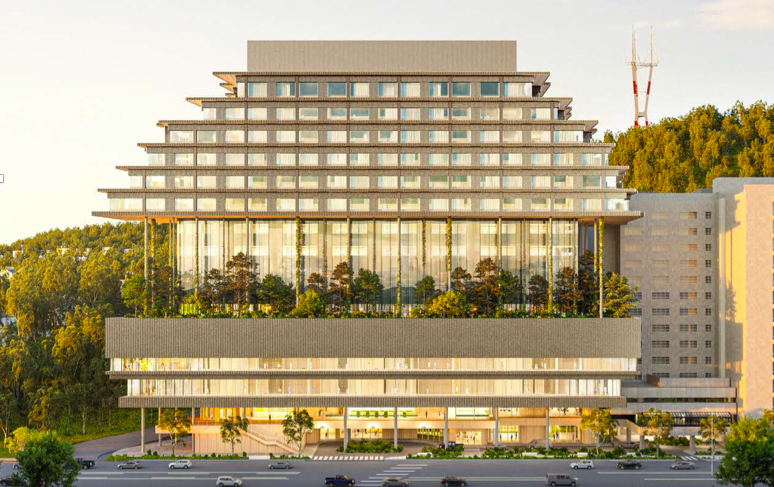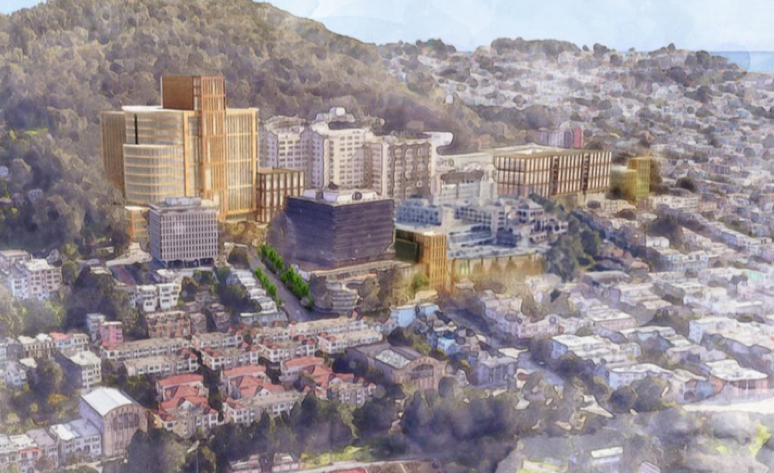UCSF has released its draft Environmental Impact Report for a new hospital at its Parnassus Campus. The plan is to build a third, 300-foot high, 15-story, 900,000-square-foot 336-bed hospital to join the existing 297-bed Long hospital and a redone 49-bed Moffit Hospital for a total of 682 beds at the Parnassus campus. Project completion is estimated to be 2030.
The problem is that the building is in the wrong part of San Francisco, making one part of the city more unlivable and the other part less healthy and wealthy.

As detailed repeatedly in 48 Hills (Oct 21 2019 , 3 June 2020, Jan 4 2021, 12 Jan 2021 , 21 Jan 21 and 24 Aug 21) the massive expansion of the UCSF Parnassus Campus violates a 40-year-old agreement between the surrounding neighborhoods and the campus on a space cap on the Parnassus Campus not only with the new hospital but another 600,000 square feet of additional construction on the already massively developed site served by a single street.
As the 48 Hills pieces report, the 40 percent increase in employees and students at the Parnassus site the build-out will create is not matched by an equal increase in either housing or public transit, thus resulting in worse Muni service and higher housing costs for all San Franciscans.
The campus building cap, mutually agreed by the community and the UC Board of Regents, was a way of limiting the impacts of unchecked expansion at the Parnassus Campus, given the fact that as a state institution the campus is exempt from local planning control. Even the Chronicle has recently raised questions about the wisdom of the unilateral breaking the long standing agreement.
What has not been fully realized or covered in the media is the benefit to the Ccty that the Parnassus site building cap created, a benefit now placed in doubt given the re-concentration of growth at the old Parnassus Campus.
The 1976 settlement agreement between the University and the community to withdraw a CEQA law suit against the School of Dentistry building not only resulted in the development cap for the Parnassus campus, but also an agreement to keep Mt. Sutro as publically assessable open space for 50 years (later made permanent and expanded to some 61 of the 107 acres at the Parnassus campus), and the return of more than 100 units of housing to private ownership in the inner Sunset. In addition, UCSF took seriously the community position, first articulated in the June 1975 Mt. Sutro Community Master Plan, of decentralizing the Parnassus Campus by seeking other locations to expand. In its final October 1975 Long Range Development Plan UCSF claimed that it would comply with the Mt. Sutro Community Master plan and “limit its size at the Parnassus Ave. Campus…UCSF will continue to decentralize its activities.”
The first example was the building of a dental clinic at the old UC Extension Campus at 100 Buchanan in the Western Addition in 1979 and adding a dental clinic SF General. Then in 1985, UCSF bought the 360,000-squre-foot Fireman’s Fund Building in Laurel Heights and put some 1,200 office workers there.
Again returning to the Western Addition, in 1990 UCSF bought Mount Zion Hospital and transformed it into the first comprehensive cancer center in Northern California.
In 1999, again at the community’s urging, newly elected Mayor Willie Brown approached UCSF with an offer to locate a new campus in the long stalled Mission Bay project. Brown brokered a deal in which the developer, Catellus, donated some 29 acres and the city donated an additional 28 acres to form the 57-acre Mission Bay Campus, an area 23 percent larger than the 46 acres open for development at Parnassus Campus.
Both UCSF and Mayor Brown acknowledged that the Parnassus development cap made the Mission Bay Campus both possible and crucial.

Over the past 20 years some 2.56 million square feet of space has been built in 13 research facilities and three hospitals at Mission Bay, employing some 3,000 folks, with some 900 housed on campus. Another 1,000 employees are in the immediate surrounding neighborhood. By 2013, more than 85,000 outpatient visits had occurred at Mission Bay. Between 2001 and 2015 some $3 billion had been invested in the Mission Bay campus by UC and its partners.
The Mission Bay Campus has been such a successful economic development node for the Mission and Bayview that former Mayors Brown and Art Agnos strongly urged the Regents to move the new hospital from Parnassus to the southeast portion of the city. The Regents declined, and voted to approve the project for the overcrowded Parnassus campus.
The three lawsuits filed against UCSF’s Parnassus plan will be heard in April and, on the outside change they prevail, the Regents may reconsider their decision. In the motion to approve the Parnassus plan, the Regents amended the resolution to require the president of the Board of Regents to be in the direct approval process should changes be required in the plan—a move seen as a partial rebuke to the campus administration, which was seen to have been less than cordial to its neighbors and actually contributing to the filing of the lawsuits.
Community advocates joined Agnos and Brown in a February, 2021 telephone conference with Regents President John Perez urging him to consider the southeast corner of San Francisco as the more fruitful location for future UCSF growth, citing, among other arguments, the clear health and employment benefits to low income and medically underserved communities in that part of the city.
The phony narrative of opposition to development pushed by developers and their front groups, and mindlessly repeated by lazy media types, that all such opposition costs jobs and money, is shown to be totally untrue in the case of the Parnassus Campus growth cap. The cap forced an otherwise dis-interested institution, protected by its special constitutional status from local controls, to in fact join forces with the city to make major investments, hire thousands of local folks, and provide accessible heath care in a part of the city plagued by disinvestment, unemployment, and ill health.
But it all started with a lawsuit based upon the California Environmental Quality Act. Perhaps, this April when three CEQA lawsuits are heard, history may be written again.




